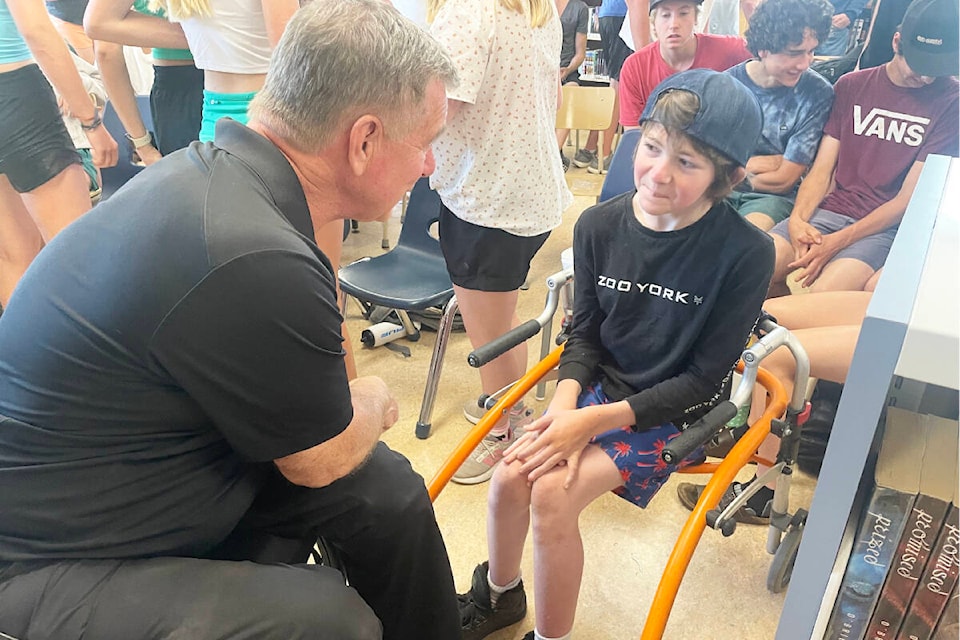As Rick Hansen navigated a high school hallway lined with students hoping to shake his hand, a teacher arrived to wonder aloud at seeing “a real-life super hero.”
On June 28, Hansen returned to the Lake City Secondary School - Columneetza campus, which Hansen attended from 1973-75, when it was a senior high.
Rick Hansen, in what was a bitter-sweet emotional moment, reflected back on where he began a lifetime of achievement in sport, advocacy and leadership.
He met with students, school administrators and his past coach, Jack Burgar.
Upon arriving at the entrance on Western Avenue, Hansen was greeted by Principal Craig Munroe and remarked on the great work the school has done since he attended, 50 years previously.
When Hansen attended in the 70s, after the injury which resulted in him losing the use of his legs, Hansen could only get into the school in his wheelchair by driving around the school and using a rear entrance.
He recalled not being able to get between classes easily and being rescued from snowbanks by fellow students when trying to get between buildings and portables in the winter months. He described it as like coming back to a foreign world. The school was both an ending and a new beginning for Hansen, whose life shifted completely after his injury.
This time, Hansen rolled his wheelchair down a long ramp to enter the school’s main doors, alongside a now retired Burgar.
Burgar had coached Hansen in basketball in Grade 10, and though he was no longer his teacher when Hansen returned to school after the injury, Burgar had visited Hansen during the many months he had been in recovery and rehabilitation in the Lower Mainland.
Hansen told Burgar how much those visits from friends, teachers and coaches meant to him all those years ago.
Burgar humbly credited Hansen’s own attitude with the progress the young teen athlete, newly confined to a wheelchair, was able to make, despite returning to a school and city unable to accommodate someone in a wheelchair who still wanted to participate in activities.
Hansen entered the gymnasium and looked around, noting how little had changed in 50 years, including a hole in the wall he recognized as being the result of an errant javelin throw from a fellow student.
Hansen recalled the talk from coach Bob Redford which helped him see things differently, pointing out the office where Redford told him that “nowhere in the definition of an athlete does it say you need to be able to use your legs in order to be one.”
Redford was also the reason Hansen did not give up after being rejected by UBC when he first applied to study physical education. Burgar encouraged Hansen to instead enrol in general studies at the school and then show them he would be able to do the physical education program.
He took Redford’s advice and became the first person in a wheelchair to graduate with a bachelor’s degree in physical education from the university.
Hansen said one of the hardest things upon his return to the school after his injury was opening the doors of the gymnasium, after having been such a dedicated athlete.
“It was tough,” he said, with a tear in his eye.
“One of your positive attributes was that you were so stubborn, persistent,” said Burgar, of the young Hansen.
Career and Life Leadership students met with Hansen in the library and he told them of the formative years he spent at the school and about his accident and how shifting his perspective to focus on what he can do helped him continue on to achieve and become a leader.
One student in particular said he was happy to get to meet Hansen, who has set an example for the young Grade 9 student.
Kaleb Paulson said Hansen inspires him and helps him believe in his own strength and abilities.
Discussing the progress in accessibility in the school, Hansen said he’s glad to see how much has improved for current students.
“I’m really proud of how far Williams Lake has come,” he said.
But he also spoke of the importance of continuing to improve, and how it is hard to believe, 50 years later, we are still trying to move up into a higher standard than minimum design codes to improve accessibility and new buildings continue to be built with barriers for accessibility.
As things improve, he said our understanding of disabilities and barriers continues to evolve, and true inclusivity will continue to develop over time.
Most of us will experience some form of disability in our lifetime, he noted, yet we continue to build barriers, especially concerning when we have an aging population.
He said teachers at the school treated him as a human being, which made all the difference and that is what everyone should think about when considering barriers to inclusivity.
READ MORE: Rick Hansen, his Cariboo supporters to lead Williams Lake Stampede Parade
READ MORE: OUR HOMETOWN: Rick Hansen, 50 years of activism
Do you have a comment about this story? email:
ruth.lloyd@wltribune.com
Like us on Facebook and follow us on Twitter.
